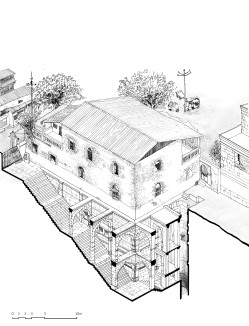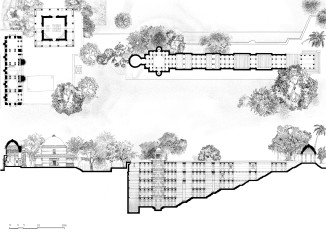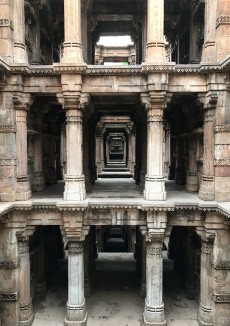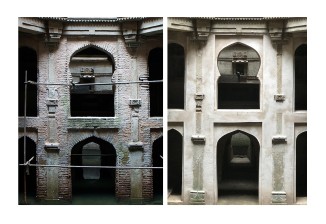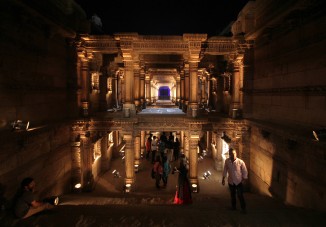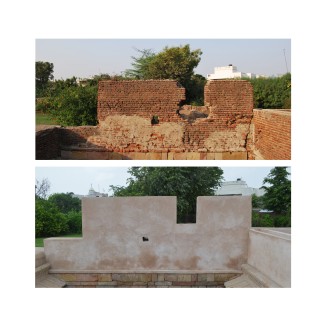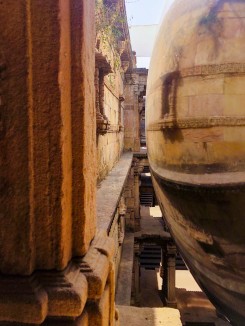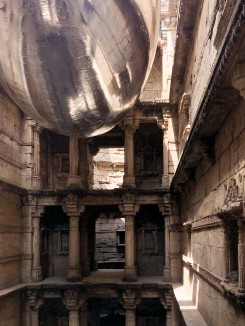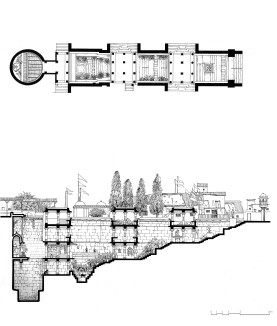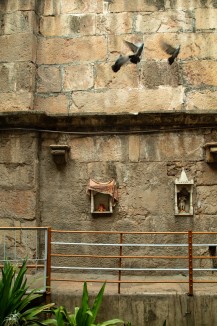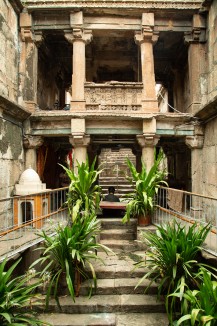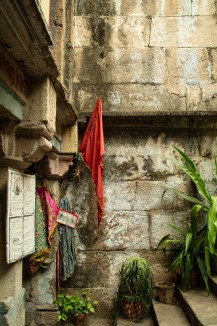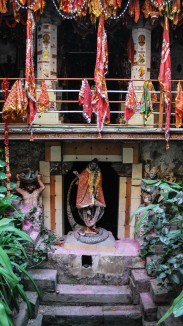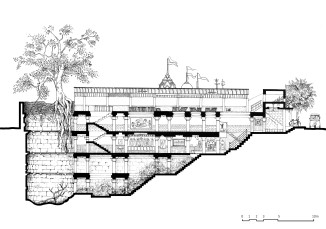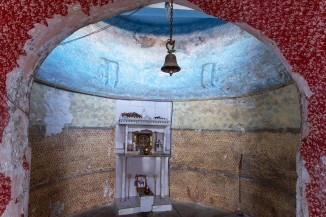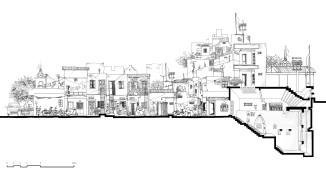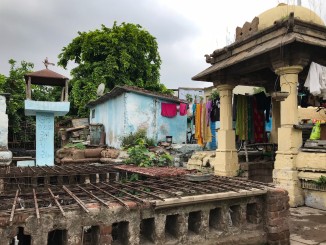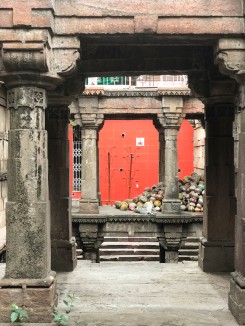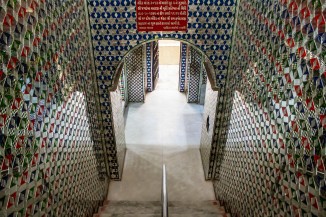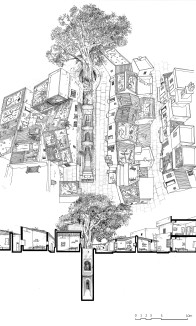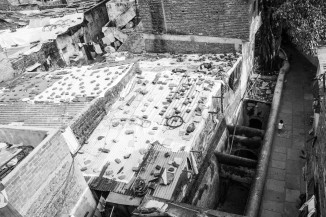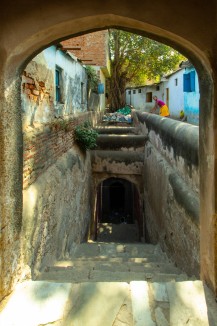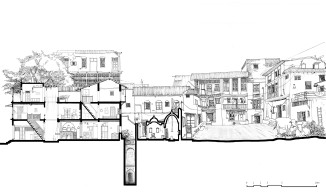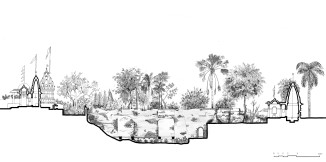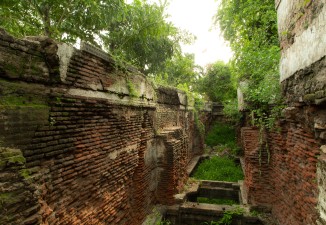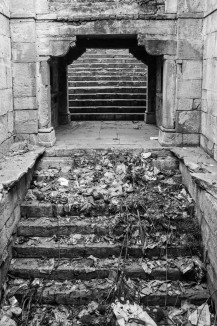Preservation, Inhabitation & Disintegration
The 18th century Amritvarshi vaav in Panchkuva, Ahmedabad is recognized as a protected monument and maintained by the Gujarat State Archaeology Department. Adjoining the L-shaped stepwell is a building from the colonial period.
The 15th century Bai Harir vaav is part of a complex of monuments managed by the Archaeological Survey of India. Adjoining the stepwell are the mosque and tomb of its patroness, Bai Harir.
Exterior view of the Bai Harir vaav, a stepwell popular with tourists and well-known to locals. Its original structure as well as its adjoining mosque and tomb remain intact.
Tiered, pillared galleries descend deep into the Bai Harir vaav. Its stonework bears the patina of time and remains mostly unaltered.
The 15th century Rudabai vaav is a monument protected by the Archaeological Survey of India. The vaav in 2013, prior to restoration (left). The vaav in 2018, after its lower level load-bearing walls were plastered (right).
Rudabai vaav lit up for the Water Festival, an annual musical event staged against the backdrop of architectural monuments. Photograph by Ancela Jamindar.
Manicured lawns maintained by the Archaeological Survey of India surround Jethabhai vaav. Dating from the mid-19th century, Jethabhai vaav is the last known stepwell built in Ahmedabad.
Restoration work conducted by the Archaeological Survey of India at the Jethabhai vaav in 2017. Plaster moldings have replaced elements such as stone ledges and ornamental brackets.
Crumbling parapet walls photographed in 2015 (top) were restored at the Jethabhai vaav by the Archaeological Survey of India in 2017 (bottom).
A site-specific sculpture by artist Vikas K Dar at the stepwell in Ambapur, presented by the Neekoee Foundation and Kiran Nadar Museum of Art. Photograph by Riyaz Tayyibji.
The site-specific installation reflects the structure of the stepwell in Ambapur. Photograph by Riyaz Tayyibji.
Plan and section of Maata Bhavani vaav in Asarwa, Ahmedabad. The stepwell no longer provides water as its well shaft has been sealed. However, it has been transformed into a temple where a goddess has been enshrined in its dry well shaft.
Plaster idols of deities, flags, bells, clay pots and other ritualistic paraphernalia have become permanent fixtures of Maata Bhavani vaav. The stepwell is deeply integrated into the life of its neighborhood, and it has become the embodiment of a living well.
Birds flock to Maata Bhavani vaav, much like pilgrims and devotees.
A visitor to the stepwell pauses in the cool depths of its lower levels. In addition to its many shrines, plants tended by local residents are now integral to Maata Bhavani vaav.
Ritualistic artifacts and potted plants contrast with the 11th century stone walls of the Maata Bhavani vaav.
The lower levels of Maata Bhavani vaav feature figures of deities and columns covered by tiles decorated with religious motifs. Devotees donate symbolic ritualistic textiles (chundari), shown in the photograph, in honor of the goddess.
At Khodiyar maata vaav, staircases have been added for temple visitors. The well’s open shafts are covered by concrete slabs that block access to its lower levels. The stepwell is hardly recognizable until one approaches the well shaft, which although uncared for, remains intact.
A goddess shrine has been installed in the rear wall of the well shaft at the Gandharva vaav in Saraspur, Ahmedabad. The walls have been painted and a prayer bell has been installed on the underside of a concrete slab covering the formerly open well shaft.
Overtaken by the vertical growth of its neighborhood, Kaali maata vaav now houses a shrine of goddess Kaali and access to its well shaft has been blocked.
An old man in the neighborhood has chosen an unusual spot for his daily siesta—he mounts his wood frame bed precariously atop the spiral staircase shaft of the Ashapura maata vaav, where cool, subterranean air flows from the well.
An informal settlement surrounds the Ashapura maata vaav, in Bapunagar, Ahmedabad, and its pavilions are used to dry clothes or for gatherings. The stepwell itself houses a temple dedicated to a goddess and is frequented by neighborhood residents.
In the Ashapura maata vaav, the first pavilion of the stepwell has been converted to a temple and covered by bright red tiles, while the rest of the structure remains untouched. The pots piled in the gallery are used by women in their temple rituals.
Colorful mirrorwork covers the wall of the Ambe maata vaav near Malav Talav in Ahmedabad, now a temple dedicated to a goddess. Though the stepwell is unrecognizable, it still accesses groundwater seasonally.
Khodiyar maata vaav at Vasna has been engulfed by an informal settlement. This stepwell is accessible through a roadside shop selling recycled furniture.
A labyrinthine mesh of narrow streets makes it difficult to find and reach the Khodiyar maata vaav in Vasna.
A majestic banyan tree has taken roots in the walls of the abandoned well at Khodiyar maata vaav in Vasna. The stepwell, however, remains overlooked by the local community.
The vaav at Doshiwada ni pol is compact and located in the dense fabric of Ahmedabad’s walled city. Built entirely in brick, it adjoins an old, traditional house with a balcony overlooking the well shaft. The age and origin of this now abandoned stepwell remain unknown.
It is unknown when the main well at the stepwell in Vadaj was infilled or when its water disappeared. A protective grill installed over the well currently collects trash.
The remnants of this partially excavated stepwell in Bhadaj include russet bricks and lush, green overgrowth. On special occasions, priests from nearby temples light the site with lamps.
The origins of this stepwell in Bhadaj remain unknown. Its lower levels and main well remain buried, while unbridled vegetation has overtaken what remains above ground.
The lower levels of the Sindhvai maata vaav are strewn with garbage, reflecting the unfortunate reality of neglected stepwells in Ahmedabad.

